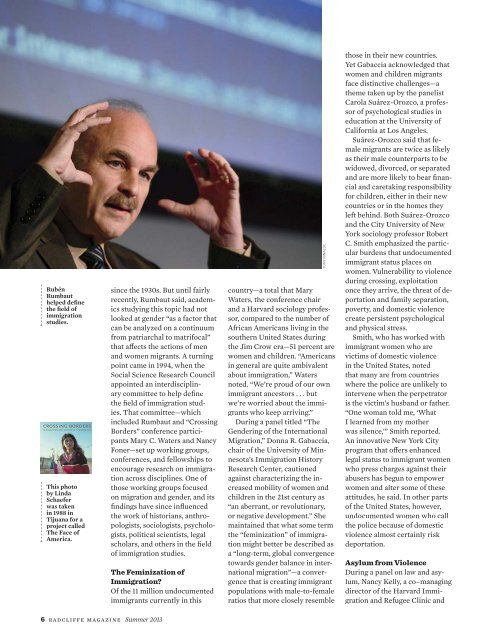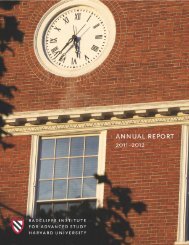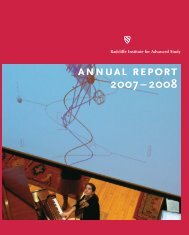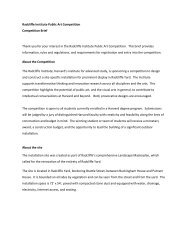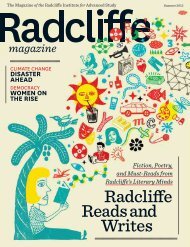Download - Radcliffe Institute for Advanced Study - Harvard University
Download - Radcliffe Institute for Advanced Study - Harvard University
Download - Radcliffe Institute for Advanced Study - Harvard University
Create successful ePaper yourself
Turn your PDF publications into a flip-book with our unique Google optimized e-Paper software.
Rubén<br />
Rumbaut<br />
helped define<br />
the field of<br />
immigration<br />
studies.<br />
crossing borders<br />
immigration and gender in the americas<br />
This photo<br />
by Linda<br />
Schaefer<br />
was taken<br />
in 1988 in<br />
Tijuana <strong>for</strong> a<br />
project called<br />
The Face of<br />
America.<br />
since the 1930s. But until fairly<br />
recently, Rumbaut said, academics<br />
studying this topic had not<br />
looked at gender “as a factor that<br />
can be analyzed on a continuum<br />
from patriarchal to matrifocal”<br />
that affects the actions of men<br />
and women migrants. A turning<br />
point came in 1994, when the<br />
Social Science Research Council<br />
appointed an interdisciplinary<br />
committee to help define<br />
the field of immigration stud-<br />
ies. That committee—which<br />
included Rumbaut and “Crossing<br />
Borders” conference participants<br />
Mary C. Waters and Nancy<br />
Foner—set up working groups,<br />
conferences, and fellowships to<br />
encourage research on immigration<br />
across disciplines. One of<br />
those working groups focused<br />
on migration and gender, and its<br />
findings have since infl<br />
uenced<br />
the work of historians, anthropologists,<br />
sociologists, psychologists,<br />
political scientists, legal<br />
scholars, and others in the field<br />
of immigration studies.<br />
The Feminization of<br />
Immigration<br />
Of the 11 million undocumented<br />
immigrants currently in this<br />
TONY RINALDO<br />
country—a total that Mary<br />
Waters, the conference chair<br />
and a <strong>Harvard</strong> sociology professor,<br />
compared to the number of<br />
African Americans living in the<br />
southern United States during<br />
the Jim Crow era—51 percent are<br />
women and children. “Americans<br />
in general are quite ambivalent<br />
about immigration,” Waters<br />
noted. “We’re proud of our own<br />
immigrant ancestors . . . but<br />
we’re worried about the immigrants<br />
who keep arriving.”<br />
During a panel titled “The<br />
Gendering of the International<br />
Migration,” Donna R. Gabaccia,<br />
chair of the <strong>University</strong> of Minnesota’s<br />
Immigration History<br />
Research Center, cautioned<br />
against characterizing the increased<br />
mobility of women and<br />
children in the 21st century as<br />
“an aberrant, or revolutionary,<br />
or negative development.” She<br />
maintained that what some term<br />
the “feminization” of immigration<br />
might better be described as<br />
a “long-term, global convergence<br />
towards gender balance in international<br />
migration”—a convergence<br />
that is creating immigrant<br />
populations with male-to-female<br />
ratios that more closely resemble<br />
those in their new countries.<br />
Yet Gabaccia acknowledged that<br />
women and children migrants<br />
face distinctive challenges—a<br />
theme taken up by the panelist<br />
Carola Suárez-Orozco, a professor<br />
of psychological studies in<br />
education at the <strong>University</strong> of<br />
Cali<strong>for</strong>nia at Los Angeles.<br />
Suárez-Orozco said that female<br />
migrants are twice as likely<br />
as their male counterparts to be<br />
widowed, divorced, or separated<br />
and are more likely to bear finan-<br />
cial and caretaking responsibility<br />
<strong>for</strong> children, either in their new<br />
countries or in the homes they<br />
left behind. Both Suárez-Orozco<br />
and the City <strong>University</strong> of New<br />
York sociology professor Robert<br />
C. Smith emphasized the particular<br />
burdens that undocumented<br />
immigrant status places on<br />
women. Vulnerability to violence<br />
during crossing, exploitation<br />
once they arrive, the threat of deportation<br />
and family separation,<br />
poverty, and domestic violence<br />
create persistent psychological<br />
and physical stress.<br />
Smith, who has worked with<br />
immigrant women who are<br />
victims of domestic violence<br />
in the United States, noted<br />
that many are from countries<br />
where the police are unlikely to<br />
intervene when the perpetrator<br />
is the victim’s husband or father.<br />
“One woman told me, ‘What<br />
I learned from my mother<br />
was silence,’” Smith reported.<br />
An innovative New York City<br />
program that offers enhanced<br />
legal status to immigrant women<br />
who press charges against their<br />
abusers has begun to empower<br />
women and alter some of these<br />
attitudes, he said. In other parts<br />
of the United States, however,<br />
undocumented women who call<br />
the police because of domestic<br />
violence almost certainly risk<br />
deportation.<br />
Asylum from Violence<br />
During a panel on law and asylum,<br />
Nancy Kelly, a co–managing<br />
director of the <strong>Harvard</strong> Immigration<br />
and Refugee Clinic and<br />
6 radcliffe magazine Summer 2013


